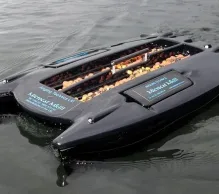A Comprehensive Guide not only for a Microcat but for any bait boat.
Angling, especially carp fishing, has seen tremendous advancements in recent years, with technology playing a significant role in enhancing the experience. One such technological marvel is the bait boat, and among the top choices is the Angling Technics Microcat bait boat. These boats have revolutionised the way anglers bait up and drop rigs, providing precision, efficiency, and convenience. In this comprehensive guide, we will delve into the best practices for using an Angling Technics Microcat bait boat to bait up and drop your rigs, ensuring you make the most of this innovative tool.
Understanding the Angling Technics Microcat Bait Boat
Before we delve into the techniques, it's essential to understand what an Angling Technics Microcat bait boat is and how it works. The Microcat is a remote-controlled vessel designed to deliver bait and rigs to specific spots in the water. This model is known for its reliability, ease of use, and advanced features such as GPS and sonar capabilities, making it a favourite among anglers.
Why Use the Angling Technics Microcat?
Using an Angling Technics Microcat offers several advantages:
- Precision: Allows for precise bait placement, even in hard-to-reach spots.
- Efficiency: Saves time and effort, especially when fishing in large waters.
- Reduced Disturbance: Minimises water disturbance compared to casting.
Getting Started with Your Angling Technics Microcat
1. Preparation
Before you head out to the water, ensure your Angling Technics Microcat is fully charged and in good working condition. Check the batteries, remote control, and any additional features like GPS or sonar. It's also wise to have a test run in a controlled environment to familiarise yourself with the controls.
2. Choosing the Right Spot
The success of using the Microcat largely depends on choosing the right spot. Use a fish finder or sonar (if available) to locate fish-holding areas. Look for features like weed beds, gravel bars, and drop-offs. Additionally, observing fish activity and understanding the behaviour of your target species can guide you to the best locations.
Baiting Up with the Angling Technics Microcat
1. Preparing the Bait
The type of bait you use can significantly impact your success. Common choices include boilies, pellets, particles, and groundbait. Ensure your bait is prepared and ready to load into the Microcat's hopper.
2. Loading the Hopper
Carefully load the bait into the hopper. Avoid overloading, as this can affect the boat's stability and performance. Some anglers prefer to mix different types of bait to create an enticing bait carpet.
3. Navigating to the Spot
Using the remote control, navigate the Microcat to the chosen spot. Take your time to ensure accuracy. If your boat has GPS capabilities, you can set waypoints for even greater precision.
4. Releasing the Bait
Once the boat is in position, release the bait. The Microcat allows you to control the release mechanism, ensuring the bait is spread evenly. If you're using a mixture of bait, try to create a broad bait carpet to increase the chances of attracting fish.
Dropping Your Rigs with the Angling Technics Microcat
1. Rig Preparation
Prepare your rigs before heading out. Popular choices for carp fishing include hair rigs, chod rigs, and bottom bait rigs. Ensure your rigs are securely tied and equipped with sharp hooks.
2. Attaching the Rig to the Boat
The Microcat has a mechanism for attaching rigs. This can be a clip or a dedicated hook holder. Secure your rig to the boat, ensuring it won't tangle during transit.
3. Navigating to the Spot
Navigate the boat to the desired location, similar to the baiting process. Precision is key, so take your time to ensure the boat is in the exact spot you want to drop the rig.
4. Dropping the Rig
Once in position, release the rig. The Microcat's dedicated rig release mechanism ensures the rig lands gently to avoid spooking the fish.
Top 5 Tips for Using the Angling Technics Microcat
- Practice Makes Perfect: Spend time practising in a controlled environment to get comfortable with the controls and manoeuvrability of your Microcat.
- Use GPS and Sonar: If your Microcat is equipped with GPS and sonar, utilise these features for precise bait placement and to locate fish-holding areas.
- Blend Your Bait: Create an attractive bait mix by combining different types of bait. This can increase the chances of attracting fish to your spot.
- Maintain Your Boat: Regularly check and maintain your Microcat to ensure it remains in good working condition. Clean the hoppers and check the batteries before each trip.
- Observe and Adapt: Pay attention to fish activity and water conditions. Be ready to adapt your strategy based on what you observe.
General Bait boat tips
Top 10 Essential Tips to Maximise Your Bait Boat's Performance
Bait boats have become an indispensable tool for modern carp anglers, offering unmatched precision and efficiency. To help you get the most out of your bait boat, we've compiled ten essential tips that will enhance your fishing experience and increase your catch rate.
1. Familiarise Yourself with Your Bait Boat
Understanding the ins and outs of your bait boat is crucial. Spend time practising in a controlled environment to get a feel for the controls and features. This familiarity will pay off when you're out on the water.
2. Maintain Your Equipment
Regular maintenance ensures your bait boat performs at its best. Clean the boat after each session, check the batteries, and inspect the propellers for any debris. A well-maintained boat will operate smoothly and last longer.
3. Use GPS and Sonar Technology
If your bait boat comes with GPS and sonar capabilities, use them to your advantage. GPS allows for precise bait placement, while sonar helps locate fish-holding areas. These features can significantly enhance your fishing strategy.
4. Create an Effective Bait Mix
An attractive bait mix can make a significant difference. Combine different types of bait, such as boilies, pellets, and particles, to create a diverse bait carpet. This variety can attract more fish to your spot.
5. Practise Accurate Baiting
Accuracy is key when baiting up with a bait boat. Take your time to position the boat precisely over your chosen spot before releasing the bait. This careful approach ensures your bait is placed exactly where you want it.
6. Use Waypoints for Consistency
Setting waypoints on your GPS-enabled bait boat can help maintain consistency. Mark productive spots and return to them with ease. This method saves time and ensures you can repeatedly hit proven areas.
7. Avoid Overloading the Hopper
While it might be tempting to load as much bait as possible, overloading the hopper can affect the boat's stability and performance. Stick to recommended capacities for optimal results.
8. Adapt to Conditions
Conditions on the water can change rapidly. Be prepared to adapt your strategy based on factors like weather, water clarity, and fish behaviour. Flexibility is crucial for successful angling.
9. Utilise Night Fishing Capabilities
Bait boats are particularly effective for night fishing. Use the boat's lights and GPS to navigate and bait up in the dark. This technique can be especially rewarding, as fish often feed more actively at night.
10. Practice Stealth
Minimise disturbances by using your bait boat quietly and efficiently. Avoid unnecessary noise and movements that could spook the fish. A stealthy approach increases your chances of success.
By following these ten tips, you can enhance your bait boat's performance and improve your carp fishing results. Whether you're a seasoned angler or a beginner, these strategies will help you make the most of your bait boat and increase your catch rate.
Advanced Techniques
1. Using Multiple Spots
Experienced anglers often use bait boats to bait up multiple spots. This can increase your chances of success by spreading your efforts across different areas. Mark these spots using GPS waypoints for easy navigation.
2. Night Fishing
Bait boats are particularly useful for night fishing. Use the Microcat's lights and GPS capabilities to navigate and bait up in the dark. This can be especially effective, as fish often feed more actively at night.
3. Long-Distance Fishing
For large waters, bait boats enable you to fish at distances that would be challenging with traditional casting. This opens up new opportunities and allows you to target areas that are less pressured.
Troubleshooting Common Issues
1. Boat Malfunctions
If your Microcat malfunctions, check the batteries and connections. Ensure the propellers are free of debris. If problems persist, consult the manufacturer's manual or seek professional repair.
2. Poor Bait Placement
If you're struggling with accurate bait placement, practice in a controlled environment. Use visual markers on the water to help guide you. GPS and sonar can also enhance accuracy.
3. Rig Tangles
To prevent rig tangles, ensure your rigs are securely attached and free of any loose ends. Some anglers use PVA bags to encase their rigs, preventing tangles during transit.
Safety Considerations
When using a bait boat, always prioritise safety:
- Stay Aware of Your Surroundings: Be mindful of other anglers and water users.
- Follow Local Regulations: Ensure you adhere to any local rules and regulations regarding bait boat usage.
- Avoid Extreme Weather: Using a bait boat in extreme weather conditions can be hazardous. Always check the forecast and avoid high winds and storms.
Conclusion
Using the Angling Technics Microcat bait boat for angling offers numerous advantages, from precise bait placement to efficient rig delivery. By following the best practices outlined in this guide, you can maximise the potential of your Microcat and enhance your fishing experience. Remember to practice regularly, maintain your equipment, and stay adaptable to changing conditions.
By incorporating these tips and techniques, you'll be well on your way to becoming a proficient bait boat angler, ready to tackle any fishing challenge that comes your way.










